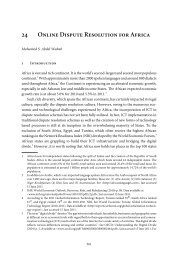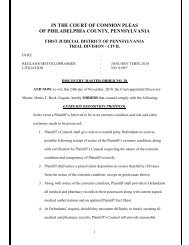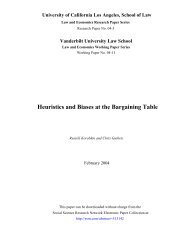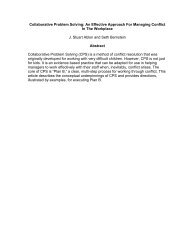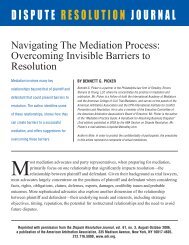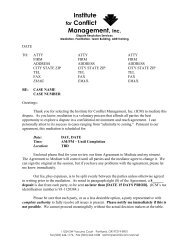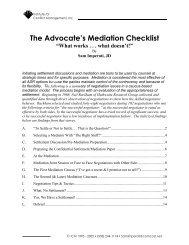17 e-Mediation - Mediate.com
17 e-Mediation - Mediate.com
17 e-Mediation - Mediate.com
Create successful ePaper yourself
Turn your PDF publications into a flip-book with our unique Google optimized e-Paper software.
Noam Ebner<br />
ered that this advantage led them to design more effective interventions. (at<br />
275)<br />
This unanimous description is very telling in terms of understanding which orientation<br />
the online environment is more conducive to. Transformative mediation processes are<br />
focused, to a large extent, on precisely those moment-to-moment interactions which<br />
mediators reported as being handily eliminated by the <strong>com</strong>munication mode. Similarly,<br />
transformative mediation is not focused (or is even “anti-focused”) on “well-crafted and<br />
effective mediator <strong>com</strong>ments and questions” in the sense that I am assuming the respondents<br />
in the study intended <strong>com</strong>ments and questions that channel disputants away from<br />
their conflict and towards resolution. Such <strong>com</strong>ments and questions get in the way of the<br />
transformative process.<br />
Given the boilerplating of disputes, and the nature of asynchronous text-based <strong>com</strong>munication,<br />
it would hardly seem likely that an eBay feedback dispute could be handled<br />
with a transformative approach. And yet, Susan Summers Raines, 54 perhaps the most<br />
experienced eBay-cases mediator of them all, suggested that this was not necessarily the<br />
case. At least, transformative elements could be adopted in the online mediator’s approach,<br />
as he or she is mindful of opportunities to highlight opportunities for empowerment and<br />
recognition along the road to resolution.<br />
Taking the above into account, it would seem that the best summary is that technology<br />
is not neutral. Text based, asynchronous <strong>com</strong>munication, the preferred mode at current<br />
in e-mediation, is conducive to mediators adopting problem-solving mindsets, and using<br />
increased degrees of evaluative and directive methods. I am in no way taking a stance<br />
against this mediator orientation or process approach; however, mediators need to consider<br />
that the medium might lead them into acting at odds with their worldview. Once aware<br />
of this, mediators should be able to realign themselves to use technology in such a manner<br />
so that is supports their worldview.<br />
In addition to the “be aware” suggestion, I will add on another: “set your stage carefully.”<br />
While it might be most practical to find a technological platform that “works” (in terms<br />
of <strong>com</strong>fort, convenience, etc.), and then to adopt a process model that <strong>com</strong>pliments it or<br />
makes best use of it, mediators aiming to be consistent and congruent with their own<br />
worldview might be well advised to take the opposite tack: Beginning with a reflection on<br />
their approach, mediators then need to find a platform or <strong>com</strong>munication medium that<br />
allows for maximum application of this approach, and continue by allowing their approach<br />
to inform the way they advertise their services, train parties in the use of their platform<br />
and conduct mediation processes.<br />
54 S. Summers Rains, “Can Online <strong>Mediation</strong> be Transformative? Tales from the Front”, Conflict Resolution<br />
Quarterly (2005) 22(4), pp. 437-451.<br />
386



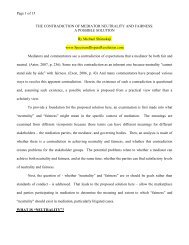
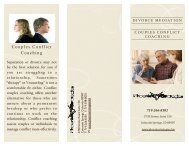
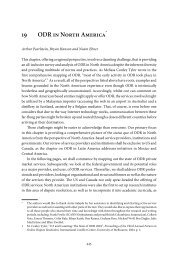
![Settlement Agreement Form [Agreement] - Mediate.com](https://img.yumpu.com/50682143/1/190x245/settlement-agreement-form-agreement-mediatecom.jpg?quality=85)

